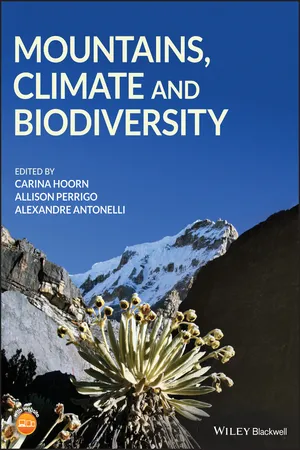
Mountains, Climate and Biodiversity
- English
- ePUB (mobile friendly)
- Available on iOS & Android
Mountains, Climate and Biodiversity
About This Book
Mountains, Climate and Biodiversity: A comprehensive and up-to-date synthesis for students and researchers
Mountains are topographically complex formations that play a fundamental role in regional and continental-scale climates. They are also cradles to all major river systems and home to unique, and often highly biodiverse and threatened, ecosystems. But how do all these processes tie together to form the patterns of diversity we see today?
Written by leading researchers in the fields of geology, biology, climate, and geography, this book explores the relationship between mountain building and climate change, and how these processes shape biodiversity through time and space.
- In the first two sections, you will learn about the processes, theory, and methods connecting mountain building and biodiversity
- In the third section, you will read compelling examples from around the world exploring the links between mountains, climate and biodiversity
- Throughout the 31 peer-reviewed chapters, a non-technical style and synthetic illustrations make this book accessible to a wide audience
- A comprehensive glossary summarises the main concepts and terminology
Readership: Mountains, Climate and Biodiversity is intended for students and researchers in geosciences, biology and geography. It is specifically compiled for those who are interested in historical biogeography, biodiversity and conservation.
Frequently asked questions
Information
1
Mountains, Climate and Biodiversity: an Introduction
Abstract
Mountains harbor about one‐quarter of all terrestrial species in about a tenth of the world’s continental surface outside Antarctica. This disproportionate diversity makes mountains a focal point for research on the generation and maintenance of biodiversity. Some of the key features that make mountains so biologically diverse are the elevational gradient, physiographic and climatic diversity, and prolonged isolation of their peaks and valleys. These features reflect the complex interactions between plate tectonics and mountain building, climate change and erosion over time scales extending to millions of years. It is now widely accepted that these large‐scale processes play a fundamental role in biotic evolution across space and time. Together with ecological interactions among organisms, they form the basis for modern biogeography. But why, when and how the interactions between the geosphere, biosphere and atmosphere resulted in such high biodiversity in mountains is insufficiently understood. In this book, a multidisciplinary team of authors discusses the state of research at the interface between the geo‐ and biospheres and addresses these and other questions, while presenting examples from mountain systems around the world.Keywords: mountain building, biodiversity, plate tectonics, geo‐biodiversity
1.1 Introduction

1.2 What are Mountains?
Table of contents
- Cover
- Title Page
- Table of Contents
- List of contributors
- Acknowledgments
- Foreword
- Biography of Editors
- Glossary
- About the Companion Website
- 1 Mountains, Climate and Biodiversity: an Introduction
- Part I: Mountains, Relief and Climate
- Part II: When Biology Meets Mountain Building
- Part III: Mountains and Biota of the World
- Index
- End User License Agreement